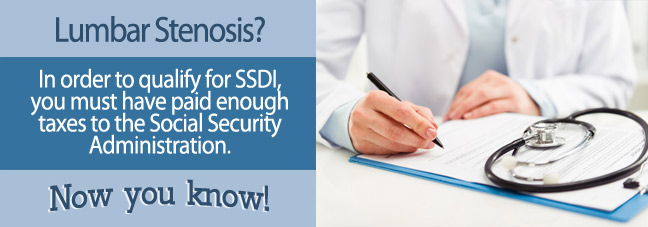If you have lumbar stenosis, the SSA’s Blue Book can help you by showing what medical evidence you need to provide to support your claim for Social Security benefits for lumbar stenosis. Lumbar stenosis is the narrowing of the open spaces in the lower (lumbar) spine.
It can exert pressure on the spinal cord and the nerves that move through the spine. The symptoms include cramping or pain in the legs when standing for sustained periods or while walking. The discomfort typically diminishes eases when sitting down or bending forward. The most common cause of lumbar stenosis is osteoarthritis which is the slow wearing and tearing that happens to joints over time.
How the Blue Book Can Help You Medically Qualify with Lumbar Stenosis
The Blue Book is written by the Social Security Administration (SSA) which lists medical conditions which are eligible to be awarded social security disability benefits. If the suffering from lumbar stenosis is so severe that the victim is diagnosed as permanently disabled and cannot handle everyday life including going to work the SSA disability assessor will refer to the Blue Book listings to assess whether the applicant is eligible to receive disability benefits.
Lumbar spinal stenosis is listed in section 1.04 of the Blue Book, under Disorders of the Spine. There is a long list of impairments and the criteria that needs to be met in order to be approved for disability benefits.

What Medical Evidence Do I Need to Win Disability Benefits With Lumbar Stenosis?
The more evidence you provide with your disability benefits application describing the effects of lumbar stenosis, the higher the chance you will have to be eligible for disability benefits. As there is no test for lumbar stenosis, your doctor’s medical records are key as a form of evidence.
They should include your current symptoms, the progression of the disease, and an assessment after a full physical examination. The report needs to cover the following:
- the pain you experience in your legs that is caused by nerve root compression;
- the difficulties you have with mobility because of pain, numbness or weakness
- your need for an assistive device, like a cane, walker or wheelchair
- the assistance you need to get up stairs;
- if you have had surgery due to lumbar stenosis a report should be included with your evidence;
- X-rays, MRIs or CT scans related to your lumbar stenosis.
- results of your residual functional capacity (RFC) assessment recorded by your physician after tasks you have been asked to perform such as sitting, standing, walking, lifting, or pushing.
Use the Blue Book as a guide to help determine the medical evidence you should include with your claim.
Help Filing for Disability Benefits with Lumbar Stenosis
A lawyer may be able to assist in helping you with your application for disability benefits with lumbar stenosis especially when it comes to using information provided in the Blue Book. The lawyer can make sure you have all the right evidence to prove the debilitating effects of lumbar stenosis so that your application is not denied.
Fill out the Free Case Evaluation on this page to get in contact with an independent, participating attorney who subscribes to the website.